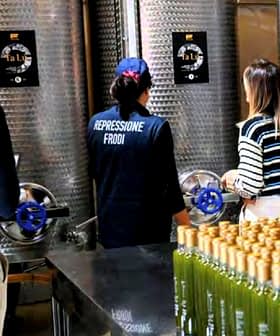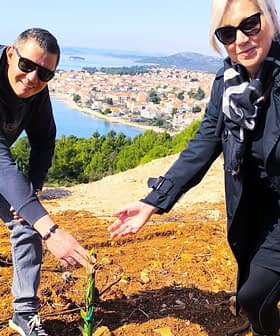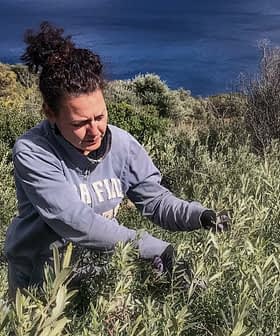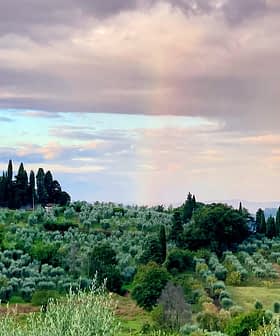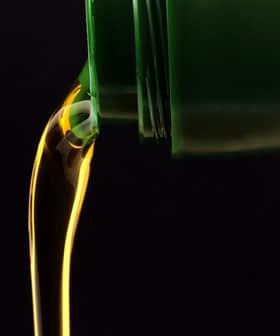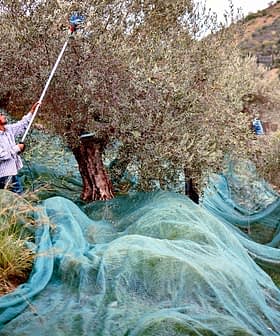Not Your "Run of the Mill" Olive Oil Tour
The article discusses the history of the Pazzi conspiracy in Tuscany, focusing on the failed attempt to murder Lorenzo de’ Medici and the subsequent fall of the Pazzi family. It also delves into the current state of the olive oil industry in Italy, highlighting issues of adulteration and lack of transparency in labeling, with producers often mixing inferior oils with olive oil and misleading consumers about the quality of their products. The article concludes with a discussion on how to identify quality Italian extra virgin olive oil and a tasting experience at Castello del Trebbio, where the olive oil is produced.
On the sixth consecutive day of rain in Tuscany, gray clouds rolled in and a clap of thunder woke all of Florence. I was already well on my way over the rising Arno River and out of the city limits, heading towards the 12th century Castello del Trebbio, birthplace of the failed “Pazzi conspiracy.” The Pazzi family were Tuscan nobles who stemmed from Pazzo, “the madman,” a soldier famous for his service during the First Crusade. Once successful bankers, yet always second-best to the powerful Medici, the Pazzi are now better known for their failed attempt to murder Lorenzo de’ Medici, while successfully killing his brother.

Giuliano de’ Medici was stabbed to death during High Mass in the Florentine Duomo on Sunday, April 26th, 1478 by a gang of Pazzi conspirators. Within days, the conspirators were seized and brutally executed, many hanging from public buildings throughout the city of Florence. The Pazzi family was stripped of its nobility, and their possessions and almost all family crests were destroyed, save for one, out of respect to the artist, Donatello.

Today the castle is inhabited by Anna Baj Macario, daughter of a wealthy Italian Count and his Austrian wife, who share a unique history of their own, although theirs is a love story. The two met and fell in love while on a train crossing the Italian-Austrian border. Anna’s mother, Eugenie Spiegel, was in her early twenties and was coming to Italy to study the language. Her father, Conte Giovanni Baj Macario, was in his sixties, a widower with no children. They were married within weeks, and over the next six years they had five children. The Count thanked his wife for giving him a second chance at life by buying Castello del Trebbio as their summer home. Before long, they had moved in full time, and began producing wine and olive oil from the prosperous surrounding Chianti landscape.
At 82, Conte Macario passed away, and in a twist of fate, his wife was unexpectedly killed in a car accident soon after, at just 43 years old. Anna, a very ambitious and dedicated woman like her mother, decided to keep the castle and carry on her family’s business, while paying off each of her siblings for their share of the estate. Anna oversees all of the olive oil production while her husband, Stefano Casadei, the winemaker, oversees their vineyards on three different estates. Cousin Alberto Peroni manages tourism at Castello del Trebbio, where he takes private groups on a tour of the castle, cantina and underground dungeon, and guides them through a tasting of the wine and olive oil.

As a recent tour guide myself, having worked during the grape and olive harvest seasons on a nearby villa in the Chianti Classico subregion of Tuscany, I was looking forward to being the tourist for once. Hoping to dig deeper into the castle’s sinister past, I found myself in a dungeon, uncovering a very different story than I had expected, yet every bit as disturbing.

Traditionally, fresh pressed olive oil was pumped into terra cotta pots called conca, which allow sediment to settle, and was then transfered into orcio, another variety of terra cotta pots where the oil was stored year round. “Oil doesn’t like light or heat,” Alberto explains. However, in recent years, this practice has been outlawed, “Terra cotta was forbidden 8 years ago by the European government. Now you must use stainless steel tanks — orci are only used for private production, not for sale.” This comes as a surprise to me, having just witnessed the use of orci for public production at the fattoria where I’d been giving tours. “Terra cotta doesn’t change the flavor very much. Honestly, I think it’s for economical reasons, because the government wants to push stainless steel,” Alberto admits.
At this point, the tour had taken a turn toward a discussion about the harsher realities of the olive oil industry. “I don’t know if you want to publish some of the things that I’m going to tell you now, because it’s something very hard,” Alberto warned me. “The more consumers want to know about olive oil, the less information they get. The Italian olive oil industry is controlled by a few big companies that, in agreement with the government, don’t give people information. The same happens in the wine business. It happens in every business; when companies are big they are protected. If you really knew what happens in the olive oil business, you wouldn’t buy certain brands anymore. That would be a problem not just for the brands, because they have hundreds of people working for them, but for the country and for the economy.”

“So the bigger the company the lesser the quality?” I ask. “Not always,” Alberto replies. He goes on to explain three main scenarios in which producers have been committing olive oil adulteration for quite some time. First, certain brands produce “Italian Extra Virgin Olive Oil” made from foreign olives. Second, companies blend a small percentage of extra virgin olive oil with virgin olive oil and sell it for top quality prices. Third, inferior seed and nut oils are passed off as extra virgin olive oil and sold to the unknowing consumer. In addition, little to no information is offered on the label, making it next to impossible for consumers to avoid being duped.
“If you consider that Tuscany makes between 5 to 10 percent of all Italian olive oil, how can you explain that in every shop in the world you can find Tuscan oil? Between 5 and 10 percent — it’s nothing, it’s a really small production. Think about it — you can’t explain it.” And you can’t explain that after the horrific frost in 1985, which destroyed olive groves all over Italy, these big companies still managed to produce and sell thousands of bottles of extra virgin olive oil. So the question is, where do the olives come from?
“When you go to a shop and you see three bottles of Tuscan olive oil, the same size, different brands, but the same words written on the label ‘Extra Virgin Olive Oil from Tuscany’ — one costs 5 euro, one costs 10 euro, one costs 15 euro — you don’t understand why there is this huge difference in price. Why does our oil cost 12 euro per liter, and in the supermarket you can find Tuscan oil for 3 euro? People don’t understand this, because the companies don’t say why.”

What’s happening with these three bottles? “First, it’s important to understand that the fundamental rule in producing healthy, top quality oil, is to pick and squeeze the olives within 24 hours. Why is that? Because pressing the olives within 24 hours gives you the possibility to keep the acidity very low — between 0.1 to 0.2 percent. People have been told for a long time that extra virgin means first press, and this is completely wrong. Extra means low acidity — just that.”
“Now, how can you find the acidity? You look on the label, right?” Wrong again. “People don’t find this information on the label — they’re finding more and more on the internet, from olive oil books and blogs, but not on the label. The Italian government doesn’t ask producers to write the acidity on their labels. They allow producers to have an oil of up to 0.8% of acid while still calling it extra virgin — meaning 0.1% or 0.79% is the same for the government.”
Here lies the first big difference in price: In order to produce an olive oil with low acidity by picking and pressing the olives in the same day, companies can either rent a machine from someone, or they can buy their own olive press. “That’s what we did. When we decided to buy our own press, we knew that we wouldn’t make a profit for 10 years. The problem with the olive press is not just the high cost, it’s the use that you make of it; only 4 weeks out of the year. So, we bought this machine for 40,000 euro, which is the smallest one on the market, and it will take us 10 years to pay for this machine that we will only use 4 weeks out of the year — it’s a lot of money. But this gives us the possibility not to squeeze the olives within 24 hours, but to squeeze them within 2 hours — we don’t have to wait, we don’t have a line, it’s our machine.”

“When you’re renting you have to pay everyday, and you get to use the oil press when the owners want, not when you want. Once we were given the use of the mill between midnight and 2 a.m. Can you imagine, after picking olives all day long having to press them every night and then in the morning having to start all over again? That’s killer for the people working here. So we decided to make this investment, but many producers don’t do this — they choose to save money. Instead of buying a machine or renting everyday, they rent just once a week after they’ve gathered a large quantity of olives.”
“Harvesting by hand hardly exists anymore, so the olives get damaged by the machines. If they get squeezed the same day, it’s ok, but when the olives sit for a week without pressing (which could certainly be the case if the olives are traveling to Italy from a foreign country), bacteria builds up, there’s fermentation, and this makes for a higher acidity — but this is not a problem for these producers, because you will never read the acidity on their label. They’ll save money even though their acidity is higher; as long as it is under 0.8% it’s still considered a top quality oil by the government. Understand that between 0.1% and 0.2% and 0.8% there’s a huge difference. People see this word, extra, and they think ‘good quality.’ No! It’s just a start.”

“You lose the word extra and it becomes only virgin olive oil if you pass 0.8% of acid. That’s checked by the chamber of commerce; they take a sample and if you have 0.9% it becomes virgin olive oil. You don’t usually find virgin olive oil in stores, because the big olive oil companies buy all the virgin oil on the market and mix it with 15% extra virgin olive oil; so they reduce a little bit the acidity of the virgin olive oil and they sell you everything as extra virgin. What does virgin mean?” Alberto asks me. “Pure,” I say, to which he responds, “untouched.”
“One day I was upstairs talking about La Bella Giardiniera…” (Ironically, this original and sacred painting by Raffaello Sanzio, to which there is only one other mate in the world, hangs in the historical conspiracy room where the Pazzi hatched their failed plan.) “I looked at the Virgin Madonna, and I thought, this is not what virgin means” anymore. “Virgin should mean that the oil was not refined, not processed, not mixed with other oils — just pure olive juice.” Virgin has lost its original meaning because the Italian government has allowed olive oil producers to bastardize the essence of the word.

“When I say that the government supports these companies, I mean that, imagine what would happen if the government said, ‘Do whatever you want, but write everything you do on the label; that you have a high acidity, that you mix virgin with extra virgin, that you buy your olives in Tunisia’ — people wouldn’t buy these brands anymore. If they don’t buy our oil it’s only our problem. If they don’t buy oil from a company that produces 10 million bottles a year, it’s a problem for Tuscany as well.”
“Olive oil — not extra and not even virgin — is rubbish. You are only allowed to call it olive oil because there are some olives in there. It is so bad that in order to sell it producers have to refine it, process it, use additives, chemicals, and mix it with other oils not from olives. That’s why it’s not virgin, it’s not untouched anymore and it’s not extra because the acidity isn’t 0.2% but can be up to 3% — 10 times more acid. That’s not good for you; maybe it’s good for your car.”

Mixing with inferior nut and seed oils is an old story in the history of Italian olive oil production. Tom Mueller shed light on the adulterated olive oil trade in his revealing article titled, “Slippery Business,” published by the New Yorker on August 13, 2007. Mueller reported that in 1991 a tanker arrived in the port of Barletta, Puglia from Ordu, Turkey, containing 2200 tons of hazelnut oil classified as “Greek Olive Oil.” Italian olive oil producer Riolio bottled and sold the oil to companies such as Nestle, Bertolli, and Unilever, which distributed the counterfeit extra virgin olive oil to consumers all over the world, while collecting $12 million in E.U. subsidies “intended to support the olive oil industry.” In 1992 the Finance Ministry’s military-police force began investigating this crime with the help of the E.U.’s anti-fraud office. By 1998, adulterated olive oil was producing profits, “comparable to cocaine trafficking, with none of the risks,” as one investigator told Mueller.
Feeling rather hopeless, I ask Alberto, “How can I be sure that what I find in the supermarket is quality Italian extra virgin olive oil, and not diesel oil more suitable for my car?” Alberto gives me three guidelines, “First, look for a dark bottle — this protects quality extra virgin olive oil from oxidation, which is caused by exposure to light. Second, check the date on the bottle. Olive oil must be consumed very young. Wine can have a short life or a long life; first it goes up in quality, then it stays at the top, and then over time it goes down in quality. It can keep for 3 years to 12 years to 20 years, doesn’t matter. Olive oil goes down from the very first day. It’s important to communicate to people when they ask how long you can keep olive oil — don’t ask how long, buy it and use it during the production year. Third, pay attention to price.” In other words, if the price is too good to be true, it
probably is.
Before leaving Castello del Trebbio, I sit down with Anna and Alberto to taste their extra virgin olive oil — a blend of 80% frantoio, 13% leccino, and 7% moraiolo. They also sell each varietal separately, allowing the consumer to taste the characteristics unique to each of these Tuscan olives. “Frantoio,” Alberto tells me, “is the soul of Tuscan oil; it’s spicy and smells distinctly of artichokes. Leccino on the other hand, is more elegant and less pungent than frantoio, while moraiolo is rather bitter on the back of the tongue.” It’s the season for olio nuovo — new oil — so I get to compare the plasma green olive juice, ripe with aromas of fresh cut grass and raw artichokes, alongside last year’s production. While it’s spicy enough to get your motor running, I’m certain that this hasn’t been cut with inferior oils or olives from who knows where — this olive oil is as pure and “untouched” as the Virgin Madonna.




